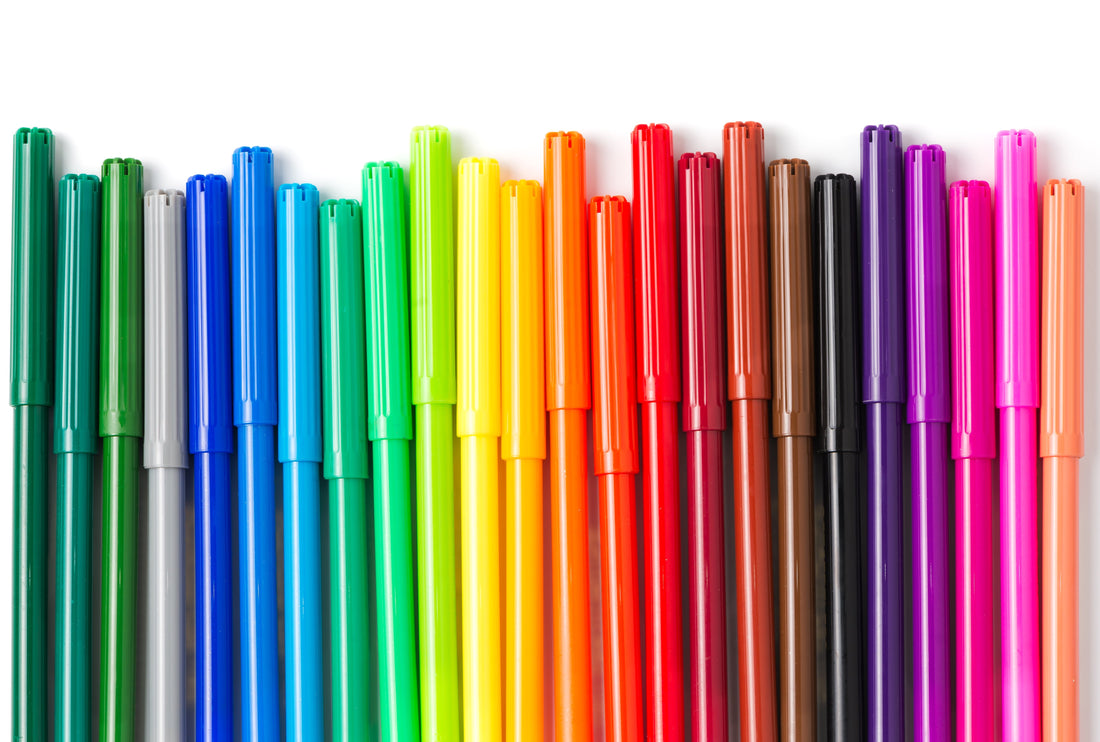
The #1 Best Markers for You | Water-based vs Alcohol-based
Share
Water-Based vs. Alcohol-Based Markers: Which Should You Choose? Markers are an essential tool for artists, designers, bullet journal enthusiasts, and crafters alike. Whether you're creating stunning illustrations, hand-lettering, or simply adding color to your planner, the type of marker you use can greatly impact the final result. Two of the most popular types of markers on the market are water-based and alcohol-based markers, each offering unique benefits and drawbacks. Understanding the differences between these two types can help you make an informed decision about which is best for your needs.
What Are Water-Based Markers?
Water-based markers use water as the primary solvent for their ink. This means that the pigments or dyes are suspended in water, making them blendable with water and easy to manipulate for various artistic effects.
Pros of Water-Based Markers
- Affordable and Widely Available They are generally more budget-friendly than alcohol-based markers. This makes them a great choice for beginners, students, or casual artists.
- Less Toxic and More Eco-Friendly Since water is the primary solvent, water-based markers are non-toxic and often safe for children. They also tend to have less odor compared to alcohol-based markers, making them more comfortable to use for extended periods.
- Blendability with Water Can be blended with water, allowing artists to create watercolor-like effects. This makes them a great option for soft gradients, washes, and expressive artworks.
- Minimal Bleed-Through on Paper Typically do not bleed through paper as much as alcohol-based markers do. This makes them ideal for bullet journaling, planners, and coloring books, where paper quality may vary.
- Easy Cleanup Because they are water-soluble, they can be easily cleaned from most surfaces, including skin and fabric, with just soap and water.
Cons of Water-Based Markers
- Less Vibrant Colors Compared to alcohol-based markers, water-based markers often have a less intense color payoff. The colors may appear more muted or faded over time.
- Paper Sensitivity Water-based markers tend to cause paper to warp or pill, especially if too much water is applied. This can be problematic when layering colors.
- Limited Blendability While they can be blended with water, they do not blend as smoothly as alcohol-based markers when used dry. Achieving seamless gradients can be challenging.
- Longer Drying Time Because the ink is water-based, it takes longer to dry compared to alcohol-based markers, increasing the risk of smudging.
What Are Alcohol-Based Markers?
Alcohol-based markers use alcohol as the solvent, allowing the ink to dry quickly and blend seamlessly. These markers are commonly used by professional artists, illustrators, and designers for their smooth application and vibrant colors.
Pros of Alcohol-Based Markers
- Vibrant and Intense Colors Alcohol-based markers produce highly saturated, vivid colors that stand out on paper, making them ideal for professional artwork.
- Smooth and Seamless Blending One of the biggest advantages of alcohol-based markers is their ability to blend seamlessly. Artists can layer colors and create smooth gradients without visible streaks.
- Quick-Drying Ink The alcohol in these markers evaporates quickly, reducing smudging and allowing for fast layering.
- Works on Various Surfaces Unlike water-based markers, alcohol-based markers can be used on multiple surfaces, including plastic, glass, wood, and metal. This makes them versatile for different projects.
- Durability and Longevity Alcohol-based ink is more permanent and resistant to fading over time. It is also waterproof once dry, making it ideal for artworks that need to last.
Cons of Alcohol-Based Markers
- More Expensive Alcohol-based markers tend to be pricier than water-based markers, making them a bigger investment for artists.
- Strong Odor Since alcohol is the solvent, these markers can have a strong smell, which some users may find unpleasant or irritating, especially in enclosed spaces.
- Bleed-Through on Paper Alcohol-based markers tend to bleed through most types of paper, requiring thick, marker-friendly paper or a protective sheet underneath.
- Harder to Correct Mistakes Since alcohol-based ink is permanent and dries quickly, mistakes can be difficult to correct, often requiring additional techniques like using a colorless blender or layering over mistakes.
- Not as Kid-Friendly Due to their strong smell and permanent ink, alcohol-based markers are not always suitable for young children or casual users who may not need such professional-grade tools.
Which Should You Choose?
Choosing between water-based and alcohol-based markers depends on your needs, preferences, and artistic goals. Here are a few considerations to help you decide:
- For Beginners and Casual Users: Water-based markers are a great choice due to their affordability, ease of use, and minimal bleed-through on paper. They work well for coloring books, bullet journaling, and school projects.
- For Professional Artists and Illustrators: Alcohol-based markers offer vibrant colors, seamless blending, and fast drying times, making them ideal for high-quality illustrations, design work, and mixed-media projects.
- For Watercolor Effects: If you enjoy soft, watercolor-like blending, water-based markers are a better choice, as they can be activated with water.
- For Durability and Longevity: If you need artwork that resists fading and is waterproof, alcohol-based markers are the superior option.
- For Mixed Media and Non-Paper Surfaces: Alcohol-based markers work better on a variety of surfaces, whereas water-based markers are generally limited to paper.
Final Thoughts
Both water-based and alcohol-based markers have their strengths and weaknesses, and the best choice ultimately depends on how you intend to use them. If you're looking for an affordable, easy-to-use option for everyday projects, water-based markers may be the best fit. These are a great option to use for bullet journals as well. On the other hand, if you're aiming for professional-quality illustrations with seamless blending and rich color payoff, alcohol-based markers are worth the investment. No matter which type of marker you choose, investing in high-quality paper and experimenting with different techniques will help you get the best results. Whether you're a beginner or an experienced artist, having a mix of both types of markers in your collection can provide the versatility you need to bring your creative visions to life!
